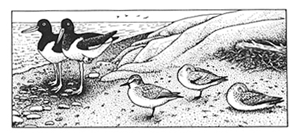|
The ability to maintain a high and constant body temperature enables birds to exploit a remarkable range of habitats -- tropical, temperate, and polar. This achievement is not without cost, however. The "expense" of metabolic heat production must be repaid by taking in sufficient energy to balance what has been expended, and mechanisms must be available to shed excess heat when necessary. If the environmental temperature falls, birds raise their metabolic rate to prevent their internal temperature from falling as well. In contrast, if the environmental temperature becomes too hot, birds must mobilize water to lose heat through evaporative cooling (as we do when we perspire) and avoid death from overheating. Since birds have no sweat glands, heat must be lost through the respiratory tract by panting, or in nonpasserines by the rapid vibration of the upper throat and thin floor of the mouth ("gular flutter"). To minimize the energy cost of temperature regulation ("thermoregulation"), birds use a variety of morphological and behavioral traits to adjust their rates of heat loss and heat gain. Unfeathered (uninsulated) body surfaces serve as important sites for heat exchange with the environment. When heat-stressed, therefore, some birds, such as Black Vultures, excrete onto their unfeathered legs to increase heat loss by evaporation. When it is cold, the lack of insulation on the legs makes them a site of potential heat loss. To minimize such loss, the arteries and veins in the legs of many birds lie in contact with each other and function as a countercurrent heat exchange system to retain heat. Arterial blood leaves the bird's core (trunk) at body temperature, while venous blood in the bird's foot is quite cool. As the cool blood returns toward the core, heat moves by conductance from the warm arteries into the cool veins. Thus, arterial blood reaching the feet is already cool and venous blood reaching the core has already been warmed. In addition, by constricting the blood vessels in its feet a bird may further decrease heat loss by reducing the amount of blood flow to its feet at low temperatures. Thus while the core temperature of a duck or gull standing on ice may be 104 degrees F, its feet may be only slightly above freezing. Behavior also can play a significant role in reducing the amount of heat lost from unfeathered surfaces. By standing on one leg and tucking the other among its breast feathers, a duck or gull on ice reduces by half the amount of unfeathered limb surface area exposed; by sitting down and thus covering both legs, heat loss from the limbs is minimized. In cold weather, juncos, sparrows, and other finches foraging on the ground frequently drop down and cover their legs and feet with their breast feathers while pausing in their search for food. On cold or windy days, shorebirds often can be seen resting with their beaks tucked away among their feathers, sometimes combined with standing on one leg or sitting. And, of course, birds can further enhance their effective insulation by fluffing out their feathers to increase the thickness of their "coat." Behavioral thermoregulation may be accomplished by other means, as well. Subtle changes in posture or orientation toward or away from the sun can alter heat gain and loss. Gulls, for example, usually nest in open habitats with little or no available shade and often face problems of overheating. Nesting Herring Gulls will rotate 180 degrees to constantly face the sun on hot, windless days. This effectively minimizes the amount of radiative heat gain by minimizing the surface area exposed to direct solar radiation and by allowing the gulls to present only their most reflective plumage (white head, neck, and breast) to direct sunlight. Gulls use their unfeathered legs and feet to prevent overheating by standing -- better yet, by standing in water. Gull chicks lack thermoregulatory ability until they are several days old and face acute problems of overheating. In many shadeless colonies, such as those of California Gulls, chicks avoid heat stress by standing in the shade provided by their parents.
In cooler weather, rather than increasing their metabolic rate, birds can save energy by using environmental heat to raise their body temperature passively. Anhingas, for example, do this by sunning with wings spread, while many small- and medium-sized species, especially passerines, assume sunning postures in which they squat or sit with their feathers slightly erected and wings drooped. Usually the bird is oriented so the back is fully exposed to the sun's direct rays. Interestingly, Greater Roadrunners and some grebes that sunbathe in this way have either back feathers with black bases or black-pigmented back skin, both of which presumably facilitate heat absorption. Birds have evolved the ability to maintain their body temperature at a somewhat lower level during periods of inactivity or in response to food deprivation. This "regulated hypothermia" achieves significant energy savings for many species ranging from passerines to raptors. For example, when deprived of food in winter, Red-tailed Hawks drop their nocturnal body temperature by 5 to 7 degrees F below their daytime temperature. Hummingbirds, swifts, and poorwills enter a state of torpor in which body temperature may drop as much as 50 degrees F for several hours during the night or for days during extremely inclement weather. Although the energy savings are great in birds that enter torpor, they face increased danger of predation because they are unable to respond quickly. There is also a substantial metabolic cost incurred by arousal from torpor that demands immediate payback in food intake. Nevertheless, recent studies indicate that the ability to enter shallow torpor for short periods may be much more widespread among birds than previously believed. Keep thermoregulatory needs in mind when you are watching birds. Indeed, temperature-regulating actions of shorebirds and gulls are among the most readily observed and interpreted of bird behaviors. SEE: Metabolism; Spread-Wing Postures; Feet. Copyright ® 1988 by Paul R. Ehrlich, David S. Dobkin, and Darryl Wheye. |
